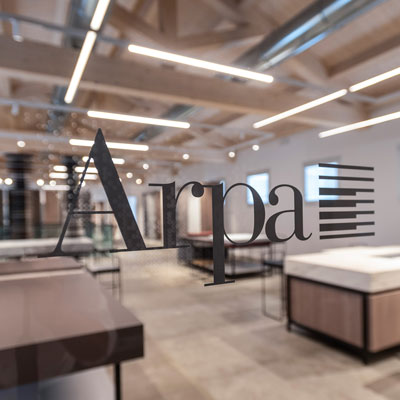A colourful selection of Arpa decors entices visitors to interact with the exhibition at Palazzo del Fumetto International Museum of Comic Art.
Palazzo del Fumetto in Pordenone (North Italy) is one of the few European museums entirely dedicated to comic books. Despite being considered the tenth art, comics are often linked to merely a hobby. However, their history dates back thousands of years: just think of the Lascaux Cave paintings (from over 17,500 years ago), a perfect example of an enormous primordial comic strip.
To tell how this popular art evolved as a blend of narration and illustration, design firm Corde Architetti Associati – based in Sacile (Pn) – has put together an exhibition based on the concept of the graphic grid, just like in a comic. The exhibition’s walls are decked out with different quadrants with calls to action for visitors, who can open doors and drawers to discover all manner of surprises. A world of art, reproductions, books and other objects are hidden within this vast array of ‘treasure chests’, filled with emotions and memories.
Photo: gerdastudio
Through Arpa’s mix of colours and material softness that echo the texture and look of comics, design becomes crucial encouraging visitors to interact with the space.
Developing an exhibition design project to tell about a diverse and hybridised art form like comics, seems quite challenging. What inspired you to accomplish so?
Comic books are, by their own nature, an art that was created to be reproduced, and this leads to writers and illustrators being bound by constraints: for example, the need to work with various types of formats and graphic layouts, that change depending on time period, country, printing technique and editorial choices.
Through this variety of format, Palazzo del Fumetto decided to explore the history of comics. So we thought to use a graphic layout to organise the exhibition’s walls, making them into a series of huge boards in which each panel presents content using different formats and media.
The concept of discovering and interacting with the space is a common thread throughout the exhibition. What form of interactivity is there at Palazzo del Fumetto?
At Palazzo del Fumetto, the call to action drives the entire exhibition and aims to engage visitors by making them protagonists, rather than spectators, using a varied array of media and technologies.
Some of the content is immediately visible on the exhibition’s walls, but most of it is suggested or hidden. The museum visit becomes an active experience, where the visitor has to do all sorts of things to access the content, such as rotating panels, opening drawers and doors, pulling out panels, pressing buttons and interacting with screens. This approach ensures engagement, garners attention and facilitates learning.
In a project where every nook and cranny of the design is intended to be touched and scrutinised, the choice of colours and materials is crucial. How do the surfaces help to guide visitors through the museum?
The walls’ external surface shows a neutral colour to match with the existing spaces, especially with the existing wooden floor. However, each room has a selection of different colours hidden within the walls, informing visitors that they are in a new section. Some open alcoves immediately suggest the room’s themed colour, but that doesn’t prevent you from pleasantly discovering, by opening a drawer or a door, that the heart of the room is different from the previous one.
They are indeed the Arpa colours to mark out Palazzo del Fumetto’s various areas. Verde Celadon, Verde Pino, Blu Berta, Maggese, Rosa Shade, Rosso Falun and Grigio Traffico: a palette that actually reminds of the cartoon atmosphere...
The world of comics makes an incredibly varied use of colours, making it challenging to pick the right palette for the museum. We wanted colours that were soft, but still had a character that fit with the comics displayed. We have used Arpa products in multiple museums already, as we adore its colour palettes – which are never dull or obvious – and the Colorsintesi range proved to be perfect for what we needed.
From a tactile perspective, materials can also make the exhibition experience more enjoyable. What did you like about the Kèr finish?
It feels like touching paper - and for a museum housing pieces that are mostly made from paper, it seemed like a very appropriate choice.

Led by Alessandro Santarossa and Giovanni Scirè Risichella, Corde Architetti Associati is based in Sacile (Pn). The studio develops projects in public and private fields and specialises in museum installations and academic spaces. A multidisciplinary team of professionals takes care of translating the creative idea into a finished project, with the aim of expanding the information perception and satisfying different types of audience. The design is based on the use of new technological solutions alongside traditional teaching methods and involves a multisensory approach. Among the main settings created: Museo della Storia dell’Istituto Superiore di Sanità and IPSE Center of Policlinico Gemelli in Rome; MUSME in Padua, winner of the Smart Building Award 2017; Palazzo del Fumetto in Pordenone, for which the studio was also in charge as technical and creative director for the museum and exhibition department.


















